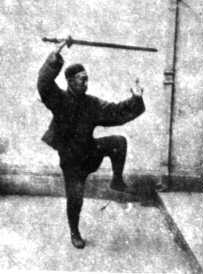The Taiji Sword

This weapon appeared rather late in the Taiji repertoire being first taught in
Beijing. The manuals of Wu Yu Xiang do not record a sword form even though there
is a sword form in the current Wu Yu Xiang style syllabus. The manual only records
the sabre and the spear/staff, this would be in keeping with the times where the
sword had already played a lesser role in combat having largely been replaced
by the sabre.
The form that was handed down by the Yangs was recorded
by in pictorial form by Chen Wei Ming who had studied under Yang Cheng Fu and
by Chen Yan Ling who had studied under Tien Shao Ling who was a student of Yang
Chien Hou and Yang Shao Hou. The form recorded by both are by and large identical
and remains the most extent traditional form of Yang Taiji sword in practice today.
The
Chinese government also created a shorter sword form based on this traditional
56 posture form of the Yang family and taught it as a health exercises to the
masses. It is much shorter and the postures have been rearranged somewhat.
Also
in the sword repertoire is the two person sticky sword practice which is akin
to the pushing hands exercise. The 13 techniques of the Taiji sword are thus practiced
actively with sensing the opponent's move and countering it using the principles
of Taijiquan. The thirteen sword techniques commonly referred to are:
1)
Whip (Chou)
2) Lead (Dai)
3) Lift (Ti)
4) Obstruct (Ge)
5) Strike
(Ji)
6) Pierce (Ci)
7) Dot (Dian)
8) Burst (Beng)
9) Stir (Jiao)
10) Press Down (Ya)
11) Split (Pi)
12) Intercept (Jie)
13) Wash (Xi)
The
sword used in Taiji Sword practice is a normal Chinese sword or chien. It is a
straight sword with two edges but only the top 1/3 of the sword is sharpened to
razor sharpness. For modern practice, an unsharpened sword is often used, in some
cases a wooden one is used. The length of the sword should suit the individual
and the old way of determining correct length is by reverse holding the sword
with a straight arm so that the sword points upwards and is behind the arm, the
sword tip should be at the same level as the ear lobe.
Though any kind
of sword may be used, avoid soft swords which are too springy and swords that
are too stiff, the sword should be slightly springy. Its weight should not be
too light, it should feel like a natural extension of the arm. Too heavy and it
may cause undue strain which is an impediment to relaxation. One should not move
to a heavy weapon straight away but start with one that is most comfortable and
progress to a heavier weapon when one improves and finds the first weapon too
light.
The finish of the traditional sword is smooth and
one should be able to see the grain of the metal through the polish. Modern swords
tend to be chromed with a layer of copper or brass underneath the chrome layer.
The older swords were hand beaten and sometimes had the name of the maker inscribed
or at least the seal of the place of manufacture. Modern swords tend to be cut
from sheet metal and then shaped by machines. Hand made sword are preferable because
of better balance, the better quality of the finish and the more compact grain
of the beaten metal. The handle should be properly fixed and not lose, it should
also not be too thin and narrow but have a large enough width for proper gripping.
Check that the handle does not have cracks due to flaws in the wood or improper
finishing or seasoning of the wood.
HOME
